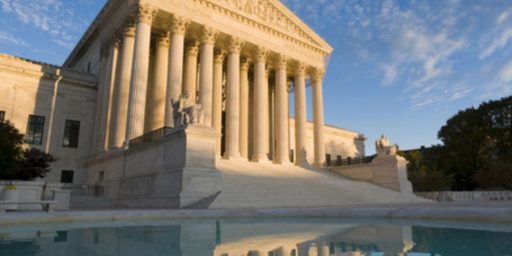Public Policy Crisis: Bears Go in the Woods
This is a page 1 story in today’s Washington Post: Animal waste is a major cause of pollution.
Does a bear leave its waste in the woods? Of course. So do geese, deer, muskrats, raccoons and other wild animals. And now, such states as Virginia and Maryland have determined that this plays a significant role in water pollution.
Scientists have run high-tech tests on harmful bacteria in local rivers and streams and found that many of the germs — and in the Potomac and Anacostia rivers, a majority of them– come from wildlife dung. The strange proposition that nature is apparently polluting itself has created a serious conundrum for government officials charged with cleaning up the rivers.
I’m not an environmental scientist but this is something I have long considered obvious. We needed a major study to figure out that wild animals poop outside? And it’s page 1 news?
It gets better!
Part of the problem lies with the unnaturally high populations of deer, geese and raccoons living in modern suburbs and depositing their waste there. But officials say it would be nearly impossible, and wildly unpopular, to kill or relocate enough animals to make a dent in even that segment of the pollution.
So, we shouldn’t try to round up all the wild animals to prevent them from pooping outside? Really? Perhaps fodder for another NSF grant: Would the animals continue producing waste if relocated?
That leaves scientists and environmentalists struggling with a more fundamental question: How clean should we expect nature to be? In certain cases, they say, the water standards themselves might be flawed, if they appear to forbid something as natural as wild animals leaving their dung in the woods. “You need to go back and say, ‘Maybe the standards aren’t exactly right’ if wildlife are causing the problem,” said Thomas Henry, an Environmental Protection Agency official who works on water pollution in the mid-Atlantic.
Well, no. Either water is safe for whatever purpose humans would put it to or it isn’t. The public policy question is what to do if it isn’t safe. Presumably, if the cause of the contaminants is human, we would redirect the activity. If it’s naturally occuring, we either stop using the water for the purposes for which it is unsafe or figure out a way to filter the water.
To some scientists, this makes perfect sense. They point out that a few wild animals have managed to thrive in the environments that humans create: Deer feast on suburban flowers; raccoons raid backyard pet-food bowls. Nonmigratory Canada geese, descended in part from geese brought to this area as live hunting decoys, have fallen so much in love with golf courses and groomed city parks that their East Coast population now stands at 1.1 million.
It could be the ultimate irony of people’s impact on nature that the entire system has changed so radically that wild animals now degrade their own environment. More animals means more bacteria-laden waste. Some of that is swept by storm water into rivers and streams.
News flash: Animals were degrading their own environment all along, just as humans have done. Life requires the consumption of resources and production of waste products. Animals adapt by changing habitats or evolving; otherwise, they die. Only humans create technological solutions to fix their environment.






Is the wildlife population truly unnaturally high? Or, has the flow of storm water runoff increased ten-fold with the paving of roads and building of sumptuous homes. Fifteen years ago, a stream cascading down a ravine where raccoons like to do their business may have overrun its banks “x” number of times, it may now do so “y” number of times since water is rushing down the hill towards the lake rather than being absorbed into the ground.
you will notice that the study doesn’t take into account manmade chemicals…seems like a rather poor study.
Where some see outrage, I see opportunity!
Right before our eyes is an entirely new profession, “Wildlife Waste Management”, open to the early bidders. Maybe this could help resolve the problems of those who’ve found their jobs “outsourced”. It certainly opens the job door to the less educated, less skilled in our societies.
And it has the bonus of woring in nature!
James: Get to work on a grant proposal for a trial project. USDA, EPA, or Interior are the most likely funders. The various state universities ought to be easily touched, too.
Go, while the mass is still warm…
“You need to go back and say, ‘Maybe the standards aren’t exactly right’ if wildlife are causing the problem,â€
I wouldn’t dismiss this to quickly. We don’t have a manual that says 36 ppm is safe but 37 ppm is unsafe. Most of the standards are set because we know that high levels of something are unsafe and that there seems to be a correlation between the amount of the thing and the number of problems that show up. So we then try to come up with an amount that we will allow. Ideally we would put it to 0, but realistically we recognize that the cost of going from 1 ppm to 0 ppm is not matched by a sufficient benefit in going from 1 ppm to 0 ppm. So to say that we need to re-think the cost to rid ourselves to the benefits of being rid of that amount is reasonable to me. If the target had been 1 ppm and with the bears in the woods we get 10 ppm, I think it is worth while re-looking at the impact of those extra 9 ppm vs the cost. If 1 ppm would average 1 human dying every 100 years and 10 ppm would average 1.1 humans dying every 100 years, then rather than kill all the raccoons and deer, perhaps we accept that additional .001 chance of a human dying in a given year. We are already accepting the .01 chance of a human dying in a given year. If it only cost $100 of additional equipment to move from the 10 ppm to 1 ppm, then the .001 chance is probably a greater cost that we want to bear given the low cost to reduce the chance.
I do think it would be useful to compare “natural” levels (aka in the wild outside of human built up areas) with the results they see here. It may be that the disruption in the ecosystem means that more animals are being left who have an especially bad poop, causing the increased problem.
The “natural” way would be for the change in population to correct itself with a die off because of the disease feedback. To many deer pooping, water gets contaminated, deer start dying off, water gets back into balance between the number of deer it can support and the number it kills off. The balance is made between the 1 and 1.1 deaths per 100 years (though usually the die off would need to involve a much higher death rate). I see nothing wrong with man using his ingenuity to short circuit the balancing equation through technology and knowledge.
MadMatt: you are a moron. The study was on harmful bacteria levels in the water. If you don’t know what bacteria is, I would suggest dusting off your middle school science textbook.
James, I am not sure if your understanding of environmental science is any better than MadMatt’s. Do you really think it is a waste of government money to fund research on finding the sources of deadly bacteria in the water supply?!?!?!?
Triumph:
As the intro to the post notes, I just presumed everyone already knew that animal waste made it into the water supply.
The highlighted quote is in response to quotes from scientists in the WaPo piece contemplating relocating the animals.
Given the quote/counterpoint format of the post, it’s bizarre that you’re having so much trouble reading it.